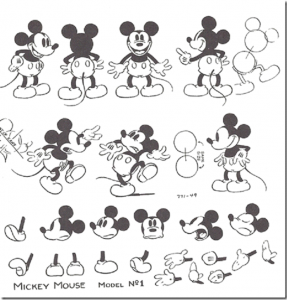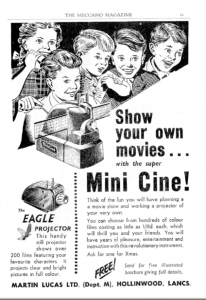(Click on the picture below to see larger version:
use your Browser’s BACK button to return to this page)
Roger Bunce
I’ve just spotted it! Page ix of December 1954 “Meccano Magazine” (see here Meccano Magazine Dec 1954) – there’s a Mini-Cine projector. I had one just like that. The film strip went rapidly up-and-down and, more slowly, sideways. The up-and-down created cyclic animation within a scene, while the sideways motion carried you from one scene to the next. Ingenious.
To see the complete Meccano Magazine issue for December 1954, you can download the whole edition.
To return to this page, use your browser’s Go Back One Page button.
Pat Heigham
I wondered whether this was, or similar to a toy projector that I had: Cine-Dux (see below).
(Click on the picture below to see larger version:
use your Browser’s BACK button to return to this page)
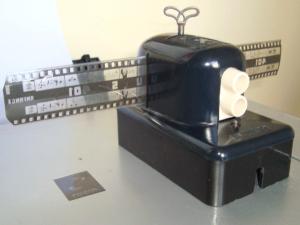
This used a strip of 35mm film, with two sets of cartoon images differing slightly in the manner of frame by frame drawn animation. The clockwork motor drove the strip slowly sideways, also operating a rotating shutter which alternately exposed the upper or lower image via a twin lens arrangement. Torch bulb illumination. I was much interested in the mechanics and wasted little time in taking the thing to bits to find out how it worked.
Later, at boarding prep school, we used to have film night once a week. The projector was a Kodascope D, silent 16mm, with films borrowed from a local photographic chemist who ran a library. It transpired that my dad had a Kodascope C inherited from an uncle, and in later years, I stripped it down and re-built it, even re-painting all the metal with Hammerite, and obtaining a renewal sprocket, the original having been damaged. It still runs perfectly, and with a wonderful smell when it gets a bit hot! Now I have a couple of 16mm ELF sound projectors, as I managed to obtain seven or so prints of movies that I worked on. However, large screen projection has given way to Hi-Def Blu-Ray projection, as I got frustrated with the poor quality of 16mm optical sound!
My interest in film led to my leaving Tech-Ops in 1969, but I’m ever grateful to the BBC for the excellent training, which stood me in good stead in the film industry, and certainly tipped the balance when applying for a job.
Roger Bunce
Yes, it looks similar in principle. I seem to remember there was a whole range of limited-animation movie projectors, including a specifically Mickey Mouse one. But the Mini-Cine I owned (aged 8) was exactly like the illustration in the “Meccano Magazine”. It was hand-cranked, rather than clockwork. The film strip was unsprocketed – a couple of inches wide, and about a foot long. There were five or six pictures, in vertical columns, to create the cyclic animation effect. I learned a lot about animation from studying them. It is an interest I have resurrected in retirement.
For those who aren’t bored with them already, a couple of my early experiments may been seen on YouTube – ‘Cameraman: the Movie’ and ‘The Battle of Beckenham’.
YouTube videos:‘Cameraman: the Movie’


For me, it all began, aged 7, with a film-show at an Uncle’s house. He showed us a black-and-white, silent, Disney cartoon, using a 9.5 mm projector (sprocket holes and scratches down the middle). The film was O.K. but it was the projector that obsessed me. The following Christmas, to shut me up, Dad made me a projector of my own – just a wooden box with a light bulb inside and a lens. It was an epidiascope. I used to cut out the picture strips from my comics, mount them on card, and slide them, frame at a time, through the projector, to give film-shows to my friends. Dad hadn’t included a mirror, so everything was projected back-to-front. This didn’t matter with the pictures, and trying to read the speech bubbles added extra comedy!
This started my interest in optics, and childish experiments with lenses. At one point I made my own Planetarium, using a tin can, a light bulb and a magnifying glass. Accurate star patterns were pricked into a sheet of tin foil, and projected onto the ceiling. It only did stars, not planets, but at least I could rotate the constellations to their correct seasonal positions.
I never felt the desire to take a projector to pieces. I’m a very non-technical sort of Techie. But from Projectors, I progressed to Cameras, and then to 8mm Cine Cameras, and then – Oh! – I seem to have become a BBC TV Cameraman.
Alec Bray
Re the advert on page ix of December 1954 “ Meccano Magazine” for the Mini-Cine projector.
Did you notice that the lad driving the projector has polydactyly.- more than the usual number of fingers?
(Click on the picture below to see larger version:
use your Browser’s BACK button to return to this page)
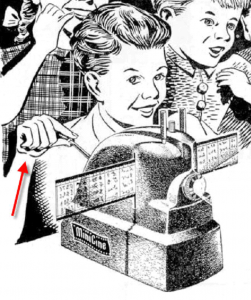
5 fingers and a Thumb.
Some three years later, 1957 , Hornby Dublo had an advert with the same problem: look at the Dad’s hand …
(Click on the picture below to see larger version:
use your Browser’s BACK button to return to this page)
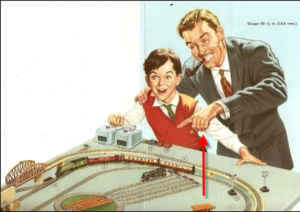
As I recall the story, when this was pointed out to Hornby, Hornby offered a free trainset to those who could prove that they had extra digits on their hands, and got rather swamped by the response. I think that nowadays extra digits are removed at birth ot thereabouts– but an extra finger could be useful on smartphones!
Maurice Fleischer
And if you ever looked closely at traditional film cartoon animation all the characters’ hands had only three fingers. Reason? 99.99% of viewers, (film or TV but discounting animators) would never notice and it saved a lot of time and money not having to draw the extra finger.
John Bennett
I noticed ages ago that the “Family Guy” cartoon characters only have 3 fingers. It surely can’t be cheaper or quicker in these computerised days, but at least they are being true to the traditions of the Genre (and it doesn’t spoil my enjoyment).
Albert Barber, Alasdair Lawrance
… and Mickey too …. and “The Simpsons”.
(Click on the picture below to see larger version:
use your Browser’s BACK button to return to this page)
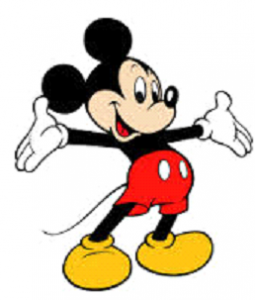
Maurice Fleischer
Done on a computer, complex animation today is easy, peasy but I was referring to hand drawn cartoon animation (yes that’s how it started until quite recently) which would consist of thousands of cells, drawn, traced, copied and painted, etc. by hundreds of animators, copiers, tracers and painters, etc. See how it adds up?
Roger Bunce
(Click on the picture below to see larger version:
use your Browser’s BACK button to return to this page)
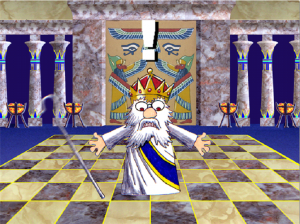
I still do hand-drawn animation (mostly on the backs of old BBC envelopes). O.K. I use a computer editing program to join all the frames together, and I use Photoshop layers instead of cells. And, instead of hundreds of animators, there’s me. But I still give them three fingers ‘cos it looks funnier.
It not so much that it saves time, but five fingers just look wrong. Trying to fit them all in, with enough detail, makes the fingers too thin or the hand too fat. It looks overcrowded, like a bunch of bananas. Wallace and Gromit are an exception. They use all five fingers, but the characters have deliberately large comedy hands.
The other mystery – What shape are Mickey Mouse’s ears?
Answer – Spherical!
They appear to be perfectly circular, whatever angle we view them from, full-face, profile, semi-profile, or whatever. The only real-world explanation is that each ear is a sphere! (They’ve broken this convention in some of this newfangled CGI stuff but, as all old codgers know – That Doesn’t Count!)
Pat Heigham
I cannot fault Roger’s theory of spherical ears, but remember that cartoons of that era were
two-dimensional, not as today’s computer renditions which have a certain 3D modelling
available.
For myself, I have always thought that Mickey’s ears and nose resembled the silhouette
of a Kodascope home projector – being the spools and lens!
(Click on the picture below to see larger version:
use your Browser’s BACK button to return to this page)
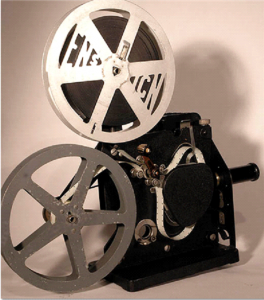
I have a Kodascope D projector, which I stripped and rebuilt – runs very sweetly.
Sadly, my good friend Les Gibbard, who animated parts of “Wind in the Willows”, died a while back, and could have given the answer to ‘three fingers’. I’ve spoken to my animator friend’s widow, who confirms that it was for speed, and ease of drawing, when you get to clean-up and cell tracing.
Maurice Fleischer
always thought Mickey Mouse got his ears from the Mitchell Camera Corporation’s 35mm film magazines…..;-)
Alec Bray
From “The Art of Walt Disney” (Abrams Art Books: ISBN 0-8109-0122-6)
“Ubi Iwerks – either on his own initiative or at Disney’s suggestion – made the figure more compact. He was constructed from two large circles, one for the trunk and one for the head, to which were appended two smaller circles, representing ears, and rubber hose arms and legs which terminated in plump hands … and large feet which gave him stability. … He was designed for maximum ease of animation (it had been discovered that circular forms were simpler to animate effectively…” (P.50)
Ubi Iwerks turned out drawings at a phenomenal rate “.. according to at least one source, as many as seven hundred a day…” (P.80)
(No, that is NOT a mistype!)
Here is a Mickey Model sheet:
(Click on the picture below to see larger version:
use your Browser’s BACK button to return to this page)
